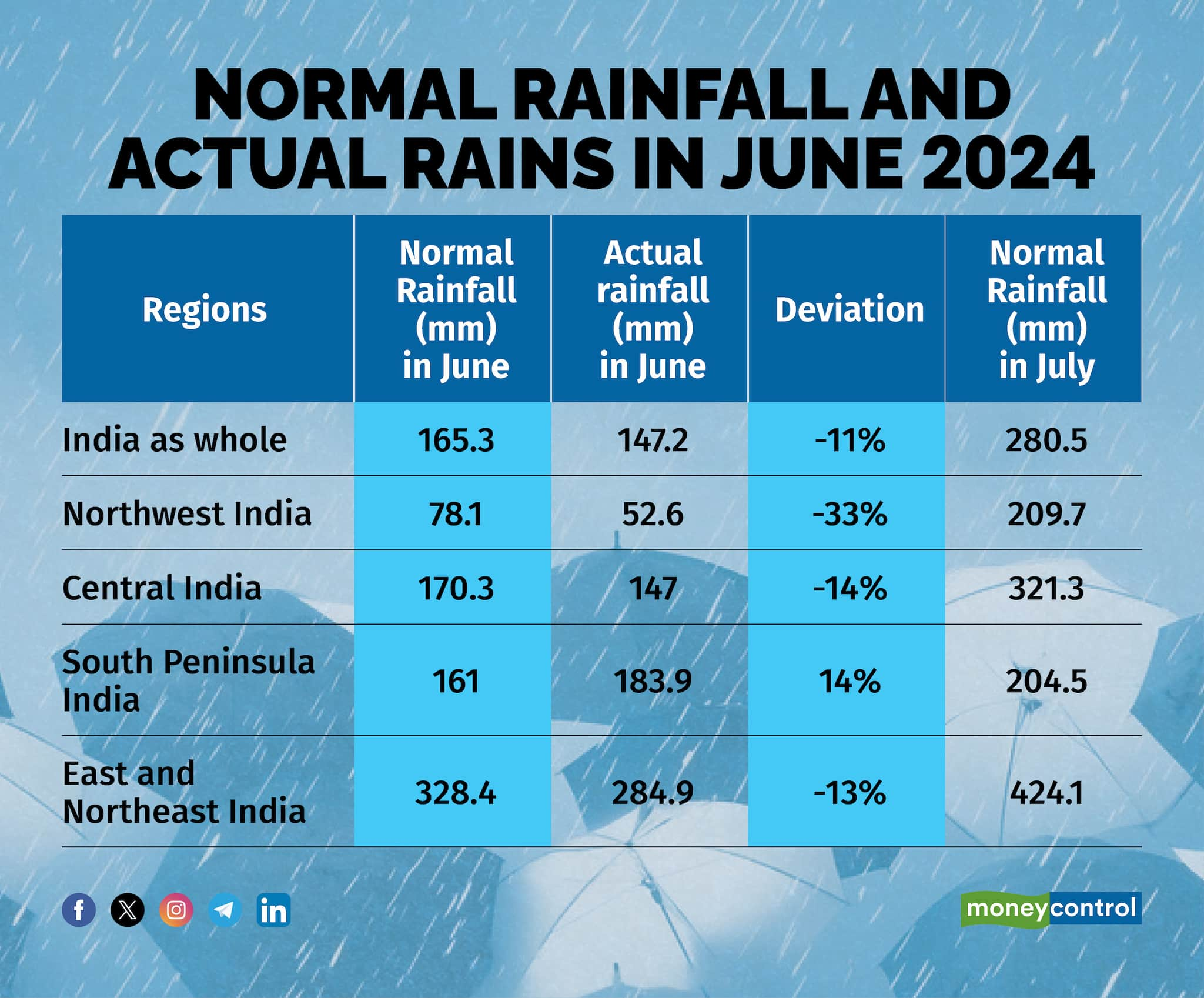



Monsoon 2024 started on a strong note but by the end of June 2024, there was a deficiency of 11%. This is the third year of deficient rainfall in June. If the forecast of IMD for subsequent months turns out to be correct and the distribution of rains is not skewed, overall production of kharif crops should still turn out to be good.
Since the monsoon first hits the southern peninsula, there is much higher rainfall in southern states in June (183.9 mm) as compared to northwest India which receives only 52.6 mm in June. The good news is that southern peninsula has received 14 percent excess rainfall. Even though Kerala (-25%) and coastal Karnataka (-14%) experienced deficient rainfall but the actual rainfall in these regions is quite high for kharif crops.
Reservoir Water Level A Concern
However, the water level in reservoirs in southern states continues to be below average.
According the Reservoir Storage Bulletin of Central Water Commission, the total live storage available in these reservoirs was 8.322 BCM on 27th June 2024. This was 16% of live storage capacity of these reservoirs. This is lower than last year’s level of 20% and normal storage level of 22% (of the last ten years).
It means that next three months will be crucial as good rainfall is needed in the remaining period of monsoon since the reservoir levels had dipped very low due to deficient rainfall last year.
Last year, due to low rainfall in Karnataka and Maharashtra, several crops suffered loss of production and productivity. Even a hardy crop like sugarcane was adversely impacted in these two states.
Pulses, A Positive Trend
Due to good rains in June, sown area under pulses should be higher. Another attractive feature for higher pulse production is much higher market prices than the MSP and public announcement by the Agriculture Minister for procurement of pulses.
The normal rainfall in central India is 70.3 mm but it received deficient rainfall of 14% (147 mm). Highest deficiency of 42% was in Gujarat followed by 28% in East Madhya Pradesh and Chhattisgarh. Saurashtra and Kutch in Gujarat and Vidarbha in Maharashtra have also experienced deficiency of 16% each.

These regions are largely rainfed and they grow castor, cow pea (lobiya), cotton, soybean, groundnut, green gram (mung) and pigeon pea (tur) etc. in kharif. If monsoon revives in early part of July, these crops may still cover a normal area and there should not be too much loss of production.
There are several vegetable crops which are grown in rainy season. These include beans, brinjal, okra, radish and cucumber etc. In addition, kharif onion and tomato are also grown in some regions. These are staple in Indian diets.
Vegetables, July Is The Key
In the last one year, vegetables have been contributing to high food inflation. In May 2024, the year-to-year inflation of vegetables was 27.3%. If monsoon rains in July turn out to be normal and well distributed, the prices of vegetables are likely to cool down by the end of September. That can be a good beginning to the festival season. It can cheer up the companies selling household items of daily consumption. It can also bring much needed relief to household budgets.
For 2024-25 crop year (July to June), the Union Government has fixed a target of production of 340 million tonnes. This is 3.4% higher than 328.8 million tonnes produced in 2023-24. The target of production in kharif crop is 159.97 million tonnes.
Paddy Procurement Remains High
Last year, despite deficient monsoon, rice production was 136.7 million tonnes. It means that production of rice did not suffer much. The Government has already procured 50 million tonnes of rice and there are another three months before Kharif Marketing Season 2023-24 comes to an end. The procurement may again reach 60 million tonnes, much more than the requirement of meeting commitment under the National Food Security Act, 2013.
Paddy (rice) cultivation needs more water than any other crop and its puddling method of cultivation requires 3,600 to 4,125 litres of water to grow 1kg of rice. Despite Government’s promotion of direct seeding method of rice cultivation, puddling method remains more common. If rainfall is deficient, farmers in north-west region of Punjab, Haryana and Western Uttar Pradesh withdraw underground water, further depleting the water level.
All in all, the Government policies and current eco-system do not as yet encourage desired level of diversification from rice to less water guzzling crops, like pulses and oilseeds.
Discover the latest Business News, Sensex, and Nifty updates. Obtain Personal Finance insights, tax queries, and expert opinions on Moneycontrol or download the Moneycontrol App to stay updated!
Find the best of Al News in one place, specially curated for you every weekend.
Stay on top of the latest tech trends and biggest startup news.